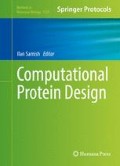Abstract
Recent advances in de novo protein design have gained considerable insight from the intrinsic dynamics of proteins, based on the integration of molecular dynamics simulations protocols on the state-of-the-art de novo protein design protocols used nowadays. With this protocol we illustrate how to set up and run a molecular dynamics simulation followed by a functional protein dynamics analysis. New users will be introduced to some useful open-source computational tools, including the GROMACS molecular dynamics simulation software package and ProDy for protein structural dynamics analysis.
Access this chapter
Tax calculation will be finalised at checkout
Purchases are for personal use only
References
Privett HK et al (2012) Iterative approach to computational enzyme design. Proc Natl Acad Sci U S A 109:3790–3795
Wolfenden R, Snider MJ (2001) The depth of chemical time and the power of enzymes as catalysts. Acc Chem Res 34:938–945
Tantillo DJ, Chen J, Houk KN (1998) Theozymes and compuzymes : biological catalysis theoretical models for biological catalysis. Curr Opin Chem Biol 2:743–750
Branco RJF, Graber M, Denis V, Pleiss J (2009) Molecular mechanism of the hydration of Candida antarctica lipase B in the gas phase: water adsorption isotherms and molecular dynamics simulations. Chembiochem 10:2913–2919
Röthlisberger D et al (2008) Kemp elimination catalysts by computational enzyme design. Nature 453:190–195
Richter F, Leaver-Fay A, Khare SSD, Bjelic S, Baker D (2011) De novo enzyme design using Rosetta3. PLoS One 6:e19230
Reitinger S et al (2010) Circular permutation of Bacillus circulans xylanase: a kinetic and structural study. Biochemistry 49:2464–2474
Bernstein FC et al (1977) The Protein Data Bank. A computer-based archival file for macromolecular structures. Eur J Biochem 80:319–324
Olsson MHM, SØndergaard CR, Rostkowski M, Jensen JH (2011) PROPKA3: consistent treatment of internal and surface residues in empirical p K a predictions. J Chem Theory Comput 7:525–537
Oostenbrink C, Villa A, Mark AE, van Gunsteren WF (2004) A biomolecular force field based on the free enthalpy of hydration and solvation: the GROMOS force-field parameter sets 53A5 and 53A6. J Comput Chem 25:1656–76
Bakan A, Meireles LM, Bahar I (2011) ProDy: protein dynamics inferred from theory and experiments. Bioinformatics 27:1575–7
Skjærven L, Yao XQ, Scarabelli G, Grant JB (2014) Integrating protein structural dynamics and evolutionary analysis with Bio3D. BMC Bioinformatics 15:339
Humphrey W, Dalke A, Schulten K (1996) VMD: visual molecular dynamics. J Mol Graph 14(33–8):27–8
Pérez F, Granger BE (2007) IPython: a system for interactive scientific computing. Comput Sci Eng 9:21–29
Brüschweiler R (1995) Collective protein dynamics and nuclear spin relaxation. J Chem Phys 102:3396
Amadei A, Ceruso MA, Di Nola A (1999) On the convergence of the conformational coordinates basis set obtained by the essential dynamics analysis of proteins’ molecular dynamics simulations. Proteins 36:419–424
Hilvert, D. (2013). Design of protein catalysts. Annual Review of Biochemistry. 10.1146/annurev-biochem-072611-101825, 82, 447–70. doi:10.1146/annurev-biochem-072611-101825
Samish, I., Gu, J., & Klein, M. L. (2009). Protein Motion: Simulation. In P. E. Bourne & J. Gu (Eds.), Structural Bioinformatics (2nd ed., pp. 909–938). Wiley-Blackwell
Acknowledgments
The authors thank the financial support from Fundação para a Ciência e a Tecnologia, Portugal, through contracts SFRH/BD/90644/2012 (H.F.C.), SFRH/BPD/69163/2010 (R.J.F.B.), and ERA-IB-2/0001/2013. This work was supported by the Unidade de Ciõncias Biomoleculares Aplicadas-UCIBIO, which is financed by national funds from FCT/MEC (UID/Multi/04378/2013) and co-financed by the ERDF under the PT2020 Partnership Agreement (POCI-01-0145-FEDER-007728). The authors would like to thank also the support from Centre National de la Recherche Scientifique (CNRS), France and FCT, Portugal, through the International Program of Scientific Cooperation (PROJECT PICS-147340).
Author information
Authors and Affiliations
Corresponding authors
Editor information
Editors and Affiliations
Rights and permissions
Copyright information
© 2017 Springer Science+Business Media New York
About this protocol
Cite this protocol
Carvalho, H.F., Barbosa, A.J.M., Roque, A.C.A., Iranzo, O., Branco, R.J.F. (2017). Integration of Molecular Dynamics Based Predictions into the Optimization of De Novo Protein Designs: Limitations and Benefits. In: Samish, I. (eds) Computational Protein Design. Methods in Molecular Biology, vol 1529. Humana Press, New York, NY. https://doi.org/10.1007/978-1-4939-6637-0_8
Download citation
DOI: https://doi.org/10.1007/978-1-4939-6637-0_8
Published:
Publisher Name: Humana Press, New York, NY
Print ISBN: 978-1-4939-6635-6
Online ISBN: 978-1-4939-6637-0
eBook Packages: Springer Protocols

